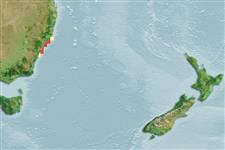>
Acropomatiformes (Oceanic basses) >
Creediidae (Sandburrowers)
Etymology: Creedia: Greek, kreesi, kreas = somebody that receives or keeps flesh (Ref. 45335).
Environment: milieu / climate zone / depth range / distribution range
Ecologia
marinhas associadas(os) a recifes; intervalo de profundidade 10 - 15 m (Ref. 9002). Subtropical
Southwest Pacific: Sydney, Australia.
Tamanho / Peso / Idade
Maturity: Lm ? range ? - ? cm
Max length : 7.0 cm TL macho/indeterminado; (Ref. 9002)
Descrição breve
Chaves de identificação | Morfologia | Morfometria
Espinhos dorsais (total) : 0; Raios dorsais moles (total) : 14 - 16; Espinhos anais: 0; Raios anais moles: 25 - 28; Vértebras: 45 - 47. Sandy colored dorsally, translucent ventrally; fins transparent (Ref. 9002).
Occurs in clean sand areas in the vicinity of rocky reefs (Ref. 9002). Buries deep in sand (Ref. 9002).
Life cycle and mating behavior
Maturities | Reprodução | Spawnings | Egg(s) | Fecundities | Larvas
Kuiter, R.H., 1993. Coastal fishes of south-eastern Australia. University of Hawaii Press. Honolulu, Hawaii. 437 p. (Ref. 9002)
Categoria na Lista Vermelha da IUCN (Ref. 130435)
Ameaça para o homem
Harmless
Utilização humana
Ferramentas
Relatórios especiais
Descarregue XML
Fontes da internet
Estimates based on models
Preferred temperature (Ref.
123201): 20.8 - 22.1, mean 21.3 °C (based on 4 cells).
Phylogenetic diversity index (Ref.
82804): PD
50 = 0.5625 [Uniqueness, from 0.5 = low to 2.0 = high].
Bayesian length-weight: a=0.00102 (0.00046 - 0.00225), b=3.06 (2.88 - 3.24), in cm total length, based on all LWR estimates for this body shape (Ref.
93245).
Nível Trófico (Ref.
69278): 3.3 ±0.4 se; based on size and trophs of closest relatives
Fishing Vulnerability (Ref.
59153): Low vulnerability (10 of 100).
